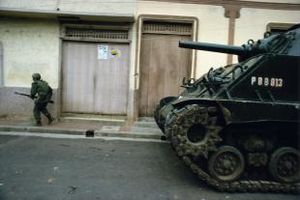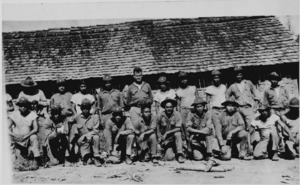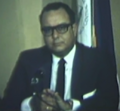National Guard (Nicaragua) facts for kids
Quick facts for kids Nicaraguan National GuardGuardia Nacional de Nicaragua |
|
|---|---|
| Established | 1925 |
| Disbanded | 1979 |
| Parts | Nicaraguan National Guard Ground Forces Air Force of the Nicaraguan National Guard Nicaraguan National Guard Navy National Police of the National Guard |
| Headquarters | Tiscapa Hill, Managua (Nicaragua) |
| Leadership | |
| Commander-in-Chief | Anastasio Somoza Debayle |
| Chief Director | See list |
| Serving soldiers | |
| Active employees/soldiers | 7,500 (January 1978) |
| Industry | |
| Suppliers from foreign countries |
|
| See also | |
| History | Nicaraguan Revolution |
| Ranks | Nicaragua military ranks |
The National Guard (Spanish: Guardia Nacional) was a special military and police force in Nicaragua. It was created in 1925 when the United States was present in Nicaragua. The National Guard became known for its harsh actions and corruption under the Somoza family's rule from 1936 to 1979. This force was officially ended when the Sandinistas took control in 1979 during the Nicaraguan Revolution.
Contents
How the National Guard Started
Before the U.S. presence, Nicaragua had many private armies due to a long period of fighting. In 1925, the Nicaraguan government asked the U.S. Marines to stay. They wanted help to train a new security force for the country. This new force was called the Guardia Nacional de Nicaragua.
U.S. forces left in 1925 but returned in 1926 after a civil war started. They took over training the National Guard from 1927 to 1933. After that, the Guard was given back to Nicaraguan control under President Juan Bautista Sacasa.
President Sacasa appointed Anastasio Somoza García as the Chief Director of the National Guard in 1925. Somoza Garcia was related to Sacasa and was trusted by the Americans. He had studied in the U.S. and trained with the U.S. Marines.
When U.S. troops left in 1933, President Sacasa tried to make peace with a rebel group. This group was led by Augusto César Sandino. Sandino had fought against both the National Guard and the U.S. forces. Sandino demanded that the National Guard be ended for any peace deal. Somoza Garcia reacted harshly. He arrested and executed Sandino, even though Sandino had been promised safe passage. The National Guard then quickly defeated Sandino's group. By this time, the National Guard had grown to about 3,000 troops.
In 1936, Somoza Garcia used the National Guard's power to remove President Sacasa. He then became president himself in 1937. He quickly took control of Nicaragua, including the National Guard. He put his friends in important positions. This started a corrupt military rule that lasted for forty years.
The Somoza Family's Rule
Under Somoza Garcia, the National Guard became the main tool for controlling Nicaragua. It managed many parts of the country, like communications, railways, and even hospitals. The Somoza family became very rich by taking over key businesses. This led to a lot of corruption, where bribery and threats were common. The U.S. supported the National Guard with military aid, especially during World War II. The Guard, which was mostly light infantry, started getting heavier equipment like armored cars and tanks.
The Somoza regime allowed some political disagreement, but it was not truly democratic. In 1947, they agreed to elections but quickly removed the winner. This made the U.S. government unhappy. However, relations improved when Nicaragua took a strong stance against communism. Somoza Garcia remained the real power. He even created a personal bodyguard unit separate from the National Guard.
In 1956, Somoza Garcia was shot and died. His older son, Luis Somoza Debayle, became president. His younger son, Anastasio Somoza Debayle, who graduated from West Point, became the Chief Director of the National Guard. After this, there was harsh repression of political opponents.
In 1961, the National Guard helped the U.S. Central Intelligence Agency (CIA) prepare for the Bay of Pigs Invasion of Cuba. They allowed their bases to be used for training. From 1965 to 1966, a company from the National Guard helped in a peacekeeping mission in the Dominican Republic. The Guard's power at home grew even more. It controlled customs, telecommunications, ports, and even civil aviation.
Even when friends of the family became president, Anastasio Somoza Debayle stayed in charge of the National Guard. In 1967, he was elected president himself. Without his brother's influence, Anastasio's corruption became even worse. A big earthquake in Managua in 1972 showed how corrupt the Guard was. Members openly stole from damaged businesses and misused international aid. Somoza Debayle's personal wealth grew a lot during the rebuilding.
By 1974, the growing Sandinista movement (FSLN) forced the government to agree to an amnesty. After this, Somoza Debayle declared a state of emergency. The National Guard launched a violent crackdown from 1975 to 1976. This weakened the FSLN, but it also weakened the Somoza regime.
The Collapse of the National Guard
The United States stopped direct military aid to Nicaragua in November 1978. However, the U.S. still hoped the National Guard could prevent a Sandinista victory. They wanted to remove the unpopular Somoza from power without the Sandinistas taking over.
In January 1978, a leader of the opposition, Pedro Joaquín Chamorro Cardenal, was killed. This caused widespread strikes and protests against the government. The National Guard was reorganized and grew to over 10,000 members. It had specialized units like armored and engineer battalions. However, the opposition only grew stronger.
On August 22, 1978, 25 Sandinista rebels, disguised as National Guard soldiers, took over the National Assembly Palace in Managua. They took 2,000 people hostage. They escaped to Panama with 50 political prisoners who were released. This event showed the weakness of the regime.
By March 1979, the Somoza government faced an open civil war. The U.S. cut off all aid, including weapons shipments. The National Guard started running low on ammunition, spare parts, and medical supplies. Their morale was low, and many soldiers were injured or left. The Guard units were forced to retreat to Managua.
On July 17, 1979, Somoza Debayle resigned and fled the country. Most of the senior military officers followed him. The interim president tried to negotiate a cease-fire. However, the National Guard, now led by General Federico Mejía González, was still ordered to fight.
Negotiations with the Sandinistas failed. On July 19, 1979, General Mejía and most high-ranking officers also left Nicaragua. This left their soldiers without leaders. Early that morning, 5,000 Sandinista fighters and 10,000 "people's militia" took control of Managua. The last senior commander of the National Guard ordered his exhausted soldiers to surrender.
About 7,500 Guardsmen were taken prisoner. Many who were suspected of human rights abuses were held by the Sandinistas. Another 4,500 officers and soldiers fled to nearby countries. They later formed the basis of an armed opposition force known as the Contras.
The Sandinista government replaced the National Guard with two new forces: the Ejército Popular Sandinista (Sandinista Popular Army) and the Policía Sandinista (Sandinista Police). Later, former members of the National Guard, with support from the CIA, became the Contra rebels.
List of Chief Directors
| No. | Portrait | Chief Director | Took office | Left office | Time in office |
|---|---|---|---|---|---|
| 1 | Major General Anastasio Somoza García (1896–1956) |
1928 | 29 September 1956 † | 27–28 years | |
| 2 | Major General Anastasio Somoza Debayle (1925–1980) |
29 September 1956 | 1960 | 3–4 years | |
| 3 | Brigadier General Gustavo Montiel |
1960 | 1966 | 5–6 years | |
| (2) | Major General Anastasio Somoza Debayle (1925–1980) |
1966 | July 1979 | 12–13 years | |
| 4 | General Federico Mejía González |
July 1979 | July 1979 | 0 months | |
| 5 | Lieutenant Colonel Fulgencio Largaespada Baez |
July 1979 | July 1979 | 0 months |
Important National Guard Officers
- Brigadier General José R. Somoza (also known as "Don José") – Inspector-general from 1976 to 1979.
- Colonel Anastasio Somoza Portocarrero (also known as "El Chigüín") – Leader of the Infantry Basic Training School (EEBI) from 1976 to 1979.
- Colonel Donaldo Humberto Frixote – Commander of the Air Force.
- Lieutenant Colonel Enrique Bermúdez Varela – Military representative in Washington, D.C. until 1979. He later led the military part of the Nicaraguan Democratic Force (FDN), a Contra group in the 1980s.
What the National Guard Wore and Used
Uniforms and Gear
From the late 1920s, National Guard soldiers wore uniforms similar to the U.S. Army. These included khaki shirts and pants, often with a special hat. Officers had different uniforms for formal events.
Over time, uniforms changed. In the 1950s and 1960s, officers wore light khaki service dress. The Air Force had royal blue uniforms, and the Navy kept white and khaki uniforms. The National Police wore khaki shirts and pants.
Later, in the late 1960s, the Guard started using U.S. Army green uniforms. Elite units wore camouflage patterns like "Duck Hunter" and "Tigerstripe." Special police teams had their own unique camouflage. Soldiers also wore different types of hats, including baseball caps and boonie hats. Special units wore colored berets: black for armored cavalry, red for paratroopers, and green for the Presidential Guard.
Soldiers wore black leather combat boots. They also used web gear from the U.S. Army to carry their equipment.
Rank and Branch Badges
The ranks in the Nicaraguan National Guard were like those in the U.S. Army. Non-commissioned officers (NCOs) had upward-pointing stripes. Officers had brass bars or stars. There were some differences in colors and names for different parts of the military. For example, Ground Forces NCOs had yellow stripes on dark green.
Officers wore special badges on their collars to show their branch. For example, crossed rifles for infantry or winged propellers for pilots. Soldiers also wore patches and shoulder titles on their sleeves to show their unit.
Weapons and Vehicles
The National Guard mainly received military help from the United States. This included uniforms, rifles, artillery, and vehicles. However, from the 1950s, the Somoza family tried to get weapons from other countries too. Most of their weapons were older U.S. surplus from past wars. After U.S. aid was cut in 1978, they got more modern equipment from countries like Israel and Spain.
Small Weapons
Early on, the Guard used Springfield US M1903 rifles and Browning Automatic Rifles. Officers and NCOs used Thompson submachine guns and Colt M1911A1 pistols.
In the 1940s and 1950s, they received more U.S. surplus weapons. These included M1/M2 carbines and M1 Garand rifles. They also got newer submachine guns and different types of revolvers. Heavier machine guns like the M1919A4 Browning and M2HB .50 Browning were added.
By the late 1960s, they started using assault rifles like the Belgian FN FAL and the U.S. M16A1. Elite units received Israeli-made IMI Galil rifles. They also used FN MAG 58 and M60 light machine guns. The Israeli Uzi 9mm submachine gun was given to armored crews and special police teams.
Soldiers also had hand grenades and rocket launchers like the M79 "Blooper" and the M72 LAW.
Mortars and Artillery
The Guard used various crew-served weapons. They had light mortars like the M2 60mm and M1 81mm. Some elite troops received heavier Soltam M-65 120mm mortars. They also used recoilless rifles of different sizes.
Their artillery included M3 37mm anti-tank guns and M101A1 105mm Howitzers. They also had Argentinian multiple rocket launchers mounted on pickup trucks. For anti-aircraft defense, they used M45 Quadmount turrets and Hispano-Suiza HS.404 20 mm autocannons.
Vehicles for Combat and Transport

The Guard had a small number of armored vehicles. These were mostly U.S. vehicles from World War II, bought in the 1950s. They included M4A3 Sherman tanks, M3A1 Stuart light tanks, and T17E1 M6 Staghound armored cars from Israel.
The Guard lacked enough armored vehicles for its infantry. So, they relied on a large fleet of unarmored transport vehicles. These included Willys MB jeeps, Dodge WC51 utility trucks, and more modern jeeps and pickups. They also had heavy transport trucks.
These vehicles were often used as "gun trucks" by adding heavy machine guns or cannons. However, they offered little protection and were easily damaged in fights. Many were lost during the 1979 civil war. The Guard also used civilian bulldozers to clear paths in rebel-held areas by knocking down buildings.
How the National Guard Was Organized in 1978–79
In January 1978, the National Guard had about 25,000 members. They were directly commanded by their Chief Director and President of Nicaragua, Major general Anastasio Somoza Debayle. The Guard was set up more for internal security and fighting rebels than for national defense. Most infantry units were assigned to guard duties in cities.
About 10,000 to 12,500 members were in the ground forces. Only about 7,500 were combat troops. These included a Presidential Guard battalion, an armored battalion, and an engineer battalion. There were also sixteen security companies spread across the country's 16 provinces. The main headquarters was in a bunker-like complex on Tiscapa Hill in Managua.
Air Force
The Air Force of the National Guard (FAGN) had about 1,500 members in 1978. They had different types of aircraft, mostly propeller-driven. All aircraft and personnel were at the military airbase next to the Mercedes International Airport in Managua.
- The combat squadron flew planes like the Cessna 337A Super Skymaster and North American T-28A/D Trojan for ground attacks.
- The helicopter squadron used Sikorsky S-58T helicopters (nicknamed "Skyraiders") for transport and gunship roles.
- The transport squadron flew planes like the Douglas C-47 Skytrain for moving troops and supplies.
The Navy of the National Guard (MG-GN) had about 1,000 sailors in 1978. They operated eight to ten Israeli Dabur-1 class patrol boats and other patrol boats. The Navy had squadrons for the Pacific and Atlantic coasts. Main naval bases were in Corinto on the Pacific coast and Puerto Cabezas on the Caribbean coast.
National Police
The National Police of the National Guard (PNGN) was created in 1970. It had about 9,000 to 10,000 male and female police officers. Most were in major cities for police duties. Some were part of the Brigadas Especiales contra Actos de Terrorismo (BECAT), which were special anti-terrorist units. These BECAT teams were like SWAT teams. They wore special camouflage uniforms and used Uzi submachine guns and M-16s. They were known for their harsh methods.
Special Forces
By July 1979, the National Guard also had about 2,000 to 2,500 elite counter-insurgency troops. These included "Black Berets" (Commandos) and "Wild Geese" (Paratroopers). They were led by Colonel Anastasio Somoza Portocarrero. These units used armed jeeps and gun-trucks.
Training for the National Guard
Between 1970 and 1976, over 4,200 Nicaraguan servicemen were trained by the United States. This training happened at places like the "School of the Americas" in Panama and Fort Bragg in the U.S.
Military Academy
The Academia Militar de Nicaragua (AMN), or Nicaraguan Military Academy, was founded in 1939. It trained officers and non-commissioned officers. It was modeled after the West Point Academy in the U.S. Early instructors were U.S. Army officers. Anastasio Somoza Debayle became its first Nicaraguan-born Director in 1948.
Infantry Basic Training School (EEBI)
The Escuela de Entrenamiento Basico de Infanteria (EEBI) was founded in 1976–77. It was a special training center for the Guard's elite anti-guerrilla Commandos and paratroopers. The school's training focused on fighting rebels. Courses included jungle combat, sniper skills, and light armor tactics. Instructors included former U.S. Special Forces and other foreign military personnel.
Images for kids
Error: no page names specified (help). In Spanish: Guardia Nacional (Nicaragua) para niños
In Spanish: Guardia Nacional (Nicaragua) para niños







